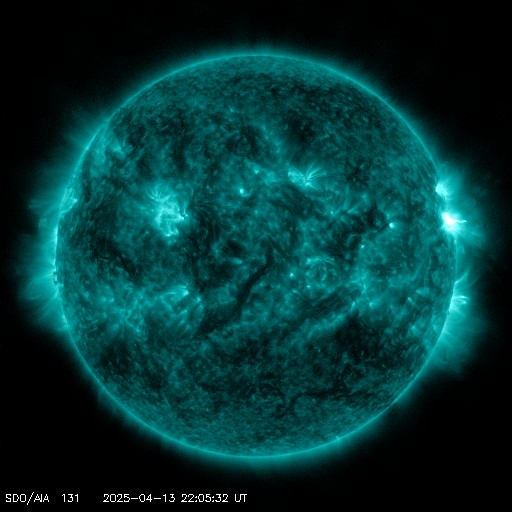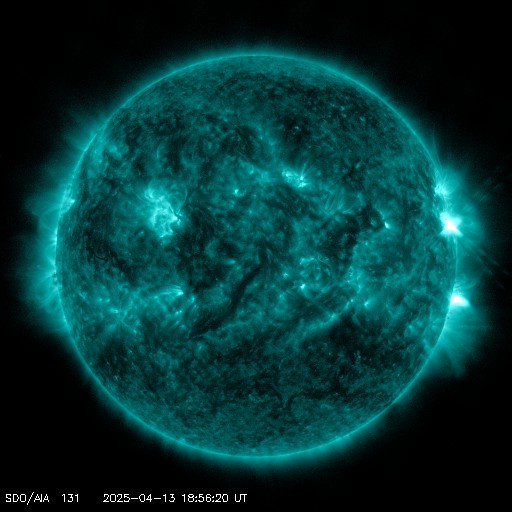Viewing archive of Friday, 13 February 2015
Daily bulletin on solar and geomagnetic activity from the SIDC
Issued: 2015 Feb 13 1254 UTC
SIDC Forecast
Solar flares
Eruptive (C-class flares expected, probability >=50%)
Geomagnetism
Quiet (A<20 and K<4)
Solar protons
Quiet
| 10cm flux | Ap | |
|---|---|---|
| 13 Feb 2015 | 126 | 008 |
| 14 Feb 2015 | 125 | 004 |
| 15 Feb 2015 | 126 | 005 |
Bulletin
Over the past 24 hours there were several B class flares and one C class flare. Most activity occurred in (Active Region) AR 2282 located close to the center of the solar disk (E10). AR 2282 produced the largest flare, a C1.0 class flare on 2015-Feb-12 peaking at 14:18 UTC. Previously active NOAA AR 2280 has moved on to the Western hemisphere limb. NOAA ARs 2280, 2281 and 2282 all appear stable, with small amounts of flux emergence. AR 2283 emerged near disk center, and may be the source of future activity. There is a large filament located between S40W02 and S10W90, however this has remained, and appears, stable. Flaring is expected to continue at the B-class level with a possibility of C-class flares. A CME with a velocity of 602 km /s (measured by CACTUS) was observed off of the Eastern limb on 2015-Feb-13 at 04:36 UTC. The source is believed to be back sided. The solar wind speed has remained stable over the past 24 hours around 350 km /s. The total magnetic field has been stable around 6 nT, and the Bz component has changed from largely negative to largely positive. The Bz has ranged between +6 and -6 nT over the past 24 hours. Geomagnetic conditions were quiet to moderate over the past 24 hours (NOAA Kp 0-2, local K Dourbes 0-3). A large transient coronal hole is currently centered at W25, as this rotates further into the Western hemisphere it may produce enhanced solar wind speeds. Solar wind conditions have been quiet, which is expected to persist. Geomagnetic conditions are expected to be quiet to unsettled with an isolated active period possible.
Today's estimated international sunspot number (ISN): 051, based on 15 stations.Solar indices for 12 Feb 2015
| Wolf number Catania | /// |
| 10cm solar flux | 128 |
| AK Chambon La Forêt | 006 |
| AK Wingst | 005 |
| Estimated Ap | 004 |
| Estimated international sunspot number | 037 - Based on 18 stations |
Noticeable events summary
| Day | Begin | Max | End | Loc | Strength | OP | 10cm | Catania/NOAA | Radio burst types | |
|---|---|---|---|---|---|---|---|---|---|---|
| None | ||||||||||
Provided by the Solar Influences Data analysis Center© - SIDC - Processed by SpaceWeatherLive
All times in UTC
Current data suggests there is a moderate possibility for aurora to appear at the following high latitude regions in the near future
Gillam, MBCurrent data suggests there is a slight possibility for aurora to appear at the following high latitude regions in the near future
Iqaluit, NUNuuk
Latest news
Latest forum messages
Support SpaceWeatherLive.com!
A lot of people come to SpaceWeatherLive to follow the Sun's activity or if there is aurora to be seen, but with more traffic comes higher server costs. Consider a donation if you enjoy SpaceWeatherLive so we can keep the website online!

Latest alerts
Sunday, 13 April 2025
22:21 UTC - Solar flare
Moderate M1.66 flare from sunspot region 4055
22:03 UTC - Radio Blackout
Minor R1 radio blackout in progress (≥M1 - current: M1.01)
20:48 UTC - Hemispheric Power Index
The OVATION model predicts the Hemispheric Power Index to reach 50GW at 21:39 UTC
19:09 UTC - Solar flare
Moderate M3.24 flare from sunspot region 4055
18:51 UTC - Radio Blackout
Minor R1 radio blackout in progress (≥M1 - current: M1.07)
Space weather facts
| Last X-flare | 2025/03/28 | X1.1 |
| Last M-flare | 2025/04/13 | M1.6 |
| Last geomagnetic storm | 2025/04/06 | Kp5 (G1) |
| Spotless days | |
|---|---|
| Last spotless day | 2022/06/08 |
| Monthly mean Sunspot Number | |
|---|---|
| March 2025 | 134.2 -20.4 |
| April 2025 | 136.4 +2.2 |
| Last 30 days | 134.2 -8.9 |




